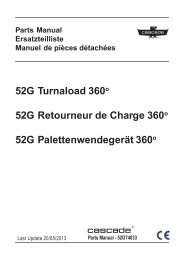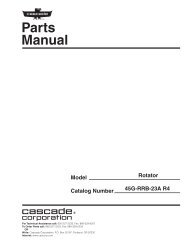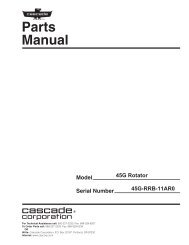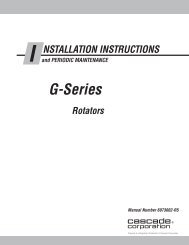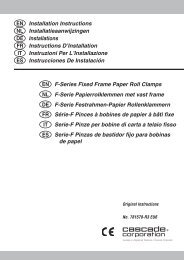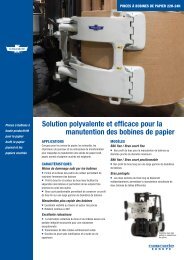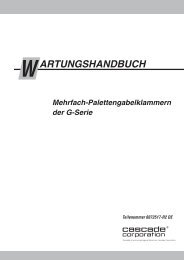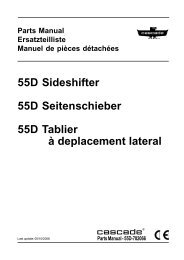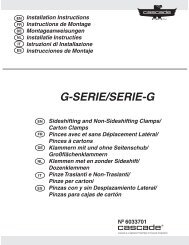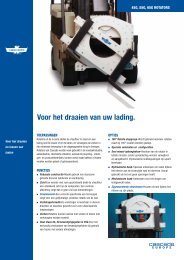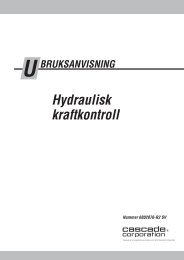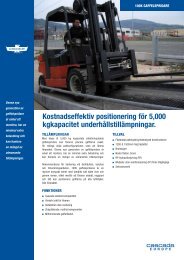6009757_C-Fork Positioner Service Manual - Cascade Corporation
6009757_C-Fork Positioner Service Manual - Cascade Corporation
6009757_C-Fork Positioner Service Manual - Cascade Corporation
Create successful ePaper yourself
Turn your PDF publications into a flip-book with our unique Google optimized e-Paper software.
S<br />
ERVICE MANUAL<br />
C-Series<br />
<strong>Fork</strong> <strong>Positioner</strong><br />
<strong>Manual</strong> Number <strong>6009757</strong><br />
cascade<br />
<strong>Cascade</strong> is a Registered Trademark of <strong>Cascade</strong> <strong>Corporation</strong><br />
�
C ONTENTS<br />
C-Series <strong>Fork</strong> <strong>Positioner</strong><br />
Page<br />
INTRODUCTION, Section 1<br />
Introduction, 1.1 1<br />
Special Definitions, 1.2 1<br />
INSTALLATION, Section 2<br />
Truck System Requirements, 2.1 2<br />
Recommended Hydraulic Supply Options, 2.2 3<br />
<strong>Fork</strong> <strong>Positioner</strong> Installation Procedure, 2.3 4<br />
PERIOD MAINTENANCE, Section 3<br />
100-Hour Maintenance, 3.1 9<br />
500-Hour Maintenance, 3.2 9<br />
1000-Hour Maintenance, 3.3 9<br />
2000-Hour Maintenance, 3.4 9<br />
TROUBLESHOOTING, Section 4<br />
General Procedures, 4.1 10<br />
Truck System Requirements, 4.1-1 10<br />
Tools Required, 4.1-2 10<br />
Troubleshooting Chart, 4.1-3 10<br />
Plumbing, 4.2 11<br />
Hosing Diagram,<strong>Fork</strong> Position Circuit, 4.2-1 11<br />
Hosing Diagram, Sideshift Circuit, 4.2-2, 4.2-3 12<br />
Hydraulic Circuit, 4.2-4, 4.2-5 14<br />
<strong>Fork</strong> Position Function, 4.3 16<br />
Supply Circuit Test, 4.3-1 16<br />
<strong>Fork</strong> Circuit Test, 4.3-2 16<br />
Valve Test, 4.3-3 17<br />
Cylinder Test, 4.3-4 17<br />
Sideshift Function, 4.4 18<br />
Supply Circuit Test, 4.4-1 18<br />
Sideshift Cylinder Test, 4.4-2 18<br />
Sideshifting Valve Test, 4.4-3 19<br />
Electrical Circuit, 4.5 20<br />
Page<br />
SERVICE, Section 5<br />
<strong>Fork</strong> <strong>Positioner</strong> Removal, 5.1 21<br />
<strong>Fork</strong>s, Shafts, 5.2 22<br />
Removal and Installation, 5.2-1 22<br />
<strong>Fork</strong> Inspection, 5.2-2 23<br />
<strong>Fork</strong> Bearing <strong>Service</strong>, 5.2-3 23<br />
<strong>Fork</strong> Carrier, 5.2-4 24<br />
Valve, 5.3 25<br />
Valve Removal, Installation, 5.3-1 25<br />
Eliminating Regeneration Circuit, 5.3-2 25<br />
Valve <strong>Service</strong>, 5.3-3 26<br />
Sideshift Cylinder, 5.4 27<br />
Cylinder Removal, Installation, 5.4-1 27<br />
Cylinder Disassembly, 5.4-2 28<br />
Cylinder Inspection, 5.4-3 28<br />
Cylinder Reassembly, 5.4-4 29<br />
<strong>Fork</strong> Position Cylinders, 5.5 30<br />
Cylinder Removal, Installation, 5.5-1 30<br />
Cylinder Disassembly, 5.5-2 31<br />
Cylinder Inspection, 5.5-3 31<br />
Cylinder Reassembly, 5.5-4 32<br />
Sideshifter Frame, 5.6 33<br />
Bearings, Anchor Plate Replacement, 5.6-1 33<br />
Solenoid Valve, 5.7 34<br />
Coil <strong>Service</strong>, 5.7-1 34<br />
Valve <strong>Service</strong>, 5.7-2<br />
SPECIFICATIONS, Section 6<br />
34<br />
Specifications, 6.1 35<br />
Hydraulics, 6.1-1 35<br />
Auxiliary Valve Functions, 6.1-2 35<br />
Truck Carriage, 6.1-3 35<br />
Torque Values, 6.1-4 36<br />
i <strong>6009757</strong> Rev. 0
I NTRODUCTION<br />
1.1 Introduction<br />
This <strong>Manual</strong> provides the Installation Instructions, Periodic<br />
Maintenance, Troubleshooting, <strong>Service</strong> and Specifications<br />
for <strong>Cascade</strong> C-Series <strong>Fork</strong> <strong>Positioner</strong>s.<br />
In any communication about the <strong>Fork</strong> <strong>Positioner</strong>, refer to<br />
the product I.D. number stamped on the nameplate as<br />
shown. If the nameplate is missing, the numbers can be<br />
found stamped on the back of the baseplate.<br />
IMPORTANT: All hoses, tubes and fittings on C-Series<br />
<strong>Fork</strong> <strong>Positioner</strong>s are JIC.<br />
NOTE: Specifications are shown<br />
in both U.S. and (Metric) units.<br />
Nameplate<br />
1.2 Special Definitions<br />
The statements shown appear throughout this <strong>Manual</strong><br />
where special emphasis is required. Read all WARNINGS<br />
and CAUTIONS before proceeding with any work.<br />
Statements labeled IMPORTANT and NOTE are provided<br />
as additional information of special significance or to<br />
make the job easier.<br />
WARNING - A statement preceded by<br />
WARNING is information that should be<br />
acted upon to prevent bodily injury. A<br />
WARNING is always inside a ruled box.<br />
CAUTION - A statement preceded by CAUTION is<br />
information that should be acted upon to prevent<br />
machine damage.<br />
FP0328.ill<br />
IMPORTANT - A statement preceded by IMPORTANT is<br />
information that possesses special significance.<br />
NOTE - A statement preceded by NOTE is information<br />
that is handy to know and may make the job easier.<br />
c<br />
SERIAL<br />
NUMBER<br />
CATALOG<br />
NUMBER<br />
ADDITIONAL<br />
EQUIPMENT<br />
ADDITIONAL<br />
EQUIPMENT<br />
ADDITIONAL<br />
EQUIPMENT<br />
cascade�<br />
LIFT TRUCK ATTACHMENT<br />
221550<br />
55C-FPB-01A<br />
ATTACHMENT CAPACITY<br />
<strong>6009757</strong> Rev. 0 1<br />
WEIGHT<br />
LBS.<br />
S/N 221550<br />
POUNDS<br />
AT<br />
INCH LOAD<br />
CENTER<br />
CAPACITY OF TRUCK AND ATTACHMENT COMBINATION<br />
MAY BE LESS THAN ATTACHMENT CAPACITY SHOWN<br />
ABOVE. CONSULT TRUCK NAMEPLATE.<br />
RECOMMENDED SYSTEM PRESSURE – 2000 PSI<br />
MAXIMUM SYSTEM PRESSURE – 2300 PSI<br />
�<br />
cascade corporation<br />
FOR TECHNICAL<br />
ASSISTANCE, CONTACT<br />
800-227–2233<br />
PORTLAND, OREGON USA<br />
FOR PARTS AND SERVICE<br />
MANUALS, CONTACT<br />
800-227–2233<br />
SPRINGFIELD, OHIO USA
I NSTALLATION<br />
2.1 Truck System<br />
Requirements<br />
C-Series <strong>Fork</strong> <strong>Positioner</strong>s will provide maximum operating<br />
capability when the following requirements are met.<br />
Truck Relief Setting<br />
GA0028.ill<br />
2000 psi (140 bar) Recommended<br />
2300 psi (160 bar) Maximum<br />
Truck Flow Volume ➀<br />
Auxiliary Valve Functions<br />
Check for compliance with ITA (ISO) standards:<br />
GA0082.ill<br />
Min. ➁ Recommended Max. ➂<br />
55C, 100C, 5 GPM 7 GPM 10 GPM<br />
120C, 150C (19 L/min.) (26 L/min.) (38 L/min.)<br />
➀ <strong>Cascade</strong> C-Series <strong>Fork</strong> <strong>Positioner</strong>s are compatible with SAE 10W<br />
petroleum base hydraulic fluid meeting Mil. Spec. MIL-0-5606 or<br />
MIL-0-2104B. Use of synthetic or aqueous base hydraulic fluid is<br />
not recommended. If fire resistant hydraulic fluid is required,<br />
special seals must be used. Contact <strong>Cascade</strong>.<br />
➁ Flow less than recommended will result in slow and unequal fork<br />
movement.<br />
➂ Flow greater than maximum can result in excessive heating,<br />
reduced system performance and reduced hydraulic system life.<br />
A<br />
Carriage Mount Dimension (A) ITA (ISO)<br />
Minimum Maximum<br />
Class II 14.96 in. (380.0 mm) 15.00 in. (381.0 mm)<br />
Class III 18.68 in. (474.5 mm) 18.74 in. (476.0 mm)<br />
Class IV 23.44 in. (595.5 mm) 23.50 in. (597.0 mm)<br />
Hoist Down<br />
Hoist Up<br />
Tilt<br />
Forward<br />
Sideshift<br />
Left<br />
Sideshift<br />
Right<br />
Tilt<br />
Back<br />
Spread <strong>Fork</strong>s<br />
Close <strong>Fork</strong>s<br />
WARNING: Rated capacity of the truck/<br />
attachment combination is a responsibility of<br />
the original truck manufacturer and may be<br />
less than that shown on the attachment<br />
nameplate. Consult the truck nameplate.<br />
GA0080.ill<br />
Carriage<br />
Clean and inspect carriage bars for<br />
damage and smoothness. Repair any<br />
protruding welds or damaged notches.<br />
2 <strong>6009757</strong> Rev 0
I NSTALLATION<br />
2.2 Recommended<br />
Hydraulic Supply<br />
Options<br />
B<br />
C-Series <strong>Fork</strong> <strong>Positioner</strong>s can be operated with any of the<br />
hydraulic supply arrangements shown below. Refer to<br />
<strong>Cascade</strong> Hose & Cable Reel Selection Guide, Part No.<br />
212199, to select the correct hose reel for the mast and<br />
truck. Hose and fitting requirements are as follows:<br />
• All hoses and fittings for the fork-positioning and<br />
sideshifting (if equipped) functions should be at least<br />
No. 6 with 9/32 in. (7 mm) minimum I.D.<br />
GA0033.ill<br />
<strong>6009757</strong> Rev. 0 3<br />
C<br />
A<br />
Non-Sideshifting<br />
A Mast Single Internal Reeving<br />
OR<br />
B RH THINLINE� 2-Port Hose Reel Group<br />
Sideshifting<br />
A Mast Double Internal Reeving<br />
OR<br />
A and B Mast Single Internal Reeving and<br />
RH THINLINE� 2-Port Hose Reel<br />
Group<br />
OR<br />
B and C RH and LH THINLINE� 2-Port Hose<br />
Reel Groups<br />
Solenoid Adaption<br />
A and B Mast Single Internal Reeving and<br />
RH Cable Reel Group<br />
OR<br />
B RH 6-N-1 Cable/Hose Reel Group
I NSTALLATION<br />
2.3 Installation Procedure<br />
Follow the steps shown to install the <strong>Fork</strong> <strong>Positioner</strong> on the<br />
truck. Read and understand all WARNING and CAUTION<br />
statements. If you don't understand a procedure, ask your<br />
supervisor, or call the nearest <strong>Cascade</strong> <strong>Service</strong> Department<br />
for assistance.<br />
2 Unlock<br />
1<br />
Quick-Change lower mounting hooks (if equipped)<br />
A Remove pin and drop hooks into unlocked position.<br />
B Re-install pin in lower hole.<br />
B<br />
Attach overhead hoist<br />
A Remove banding.<br />
B Attach hoist to top of backrest as<br />
shown and lift Attachment into vertical<br />
position on pallet. Use wood blocking<br />
as required to stabilize Attachment.<br />
C Remove bolt-on lower mounting hooks<br />
(if equipped).<br />
Guide<br />
Pin<br />
Bolt-On<br />
Lower<br />
Hooks<br />
cascade ®<br />
C-675514-1<br />
C<br />
Wood Blocking<br />
B<br />
A<br />
LH lower<br />
Hook<br />
5/8-in. (16 mm)<br />
offset on top<br />
provides max.<br />
clearance.<br />
NOTE: Guides can be reversed to<br />
reduce hook-to-carriage clearance<br />
(See lower hook installation, Step 6).<br />
4 <strong>6009757</strong> Rev 0<br />
B<br />
WARNING: Make sure overhead<br />
hoist has a rated capacity of at<br />
least 2000 lbs. (910 kg.)<br />
FP0202.ill<br />
CL0097.ill<br />
Tighten Capscrews:<br />
Class II / III Mounting – 165 ft.-lbs. (225 Nm)<br />
Class IV Mounting – 190 ft.-lbs. (255 Nm)
I NSTALLATION<br />
3<br />
Mount <strong>Fork</strong> <strong>Positioner</strong> on truck<br />
A Center truck behind Attachment.<br />
B Hang Attachment onto truck carriage, or raise<br />
carriage into upper hooks (see inset).<br />
C Engage upper mounting hooks or sideshifting<br />
full-length upper hook. IMPORTANT: If<br />
sideshifter equipped, assure upper bearings<br />
are installed properly and centering tab<br />
engages center notch on truck carriage bar.<br />
ITA Class II – 0.60–0.66 in. (15–17 mm)<br />
ITA Class III – 0.72–0.78 in. (18–20 mm)<br />
ITA Class IV – 0.72–0.78 in. (18–20 mm)<br />
ITA Class II – 0.32–0.36 in. (8–9 mm)<br />
ITA Class III – 0.39–0.43 in. (10–11 mm)<br />
ITA Class IV – 0.47–0.51 in. (12–13 mm)<br />
4 Install<br />
or engage lower hooks<br />
Tap tight into position.<br />
If sideshifter, back off<br />
1 notch and<br />
check clearance:<br />
3/32 in. (2.4 mm) min.<br />
3/16 in. (4.8 mm) max.<br />
BOLT-ON TYPE<br />
������<br />
Tighten Capscrews:<br />
Class II, III Mounting – 165 ft.-lbs. (225 Nm)<br />
Class IV Mounting – 190 ft.-lbs. (255 Nm)<br />
Center<br />
Notch<br />
Truck<br />
Carriage<br />
SS0140.ill<br />
Sideshifting full-length<br />
upper hook shown<br />
Lower<br />
Carriage<br />
Bar<br />
Slide hook up<br />
to engage<br />
bar, install<br />
pin in locked<br />
position.<br />
(upper hole.)<br />
<strong>6009757</strong> Rev. 0 5<br />
C<br />
SS0139.ill<br />
FP0213.ill<br />
Back (Driver's) View<br />
B<br />
QUICK-DISCONNECT TYPE<br />
(optional)<br />
cascade ®<br />
C-675514-1<br />
C<br />
Lower<br />
Carriage<br />
Bar<br />
SS0141.ill<br />
B<br />
FP0366.ill<br />
SD0023.ill<br />
Sideshifter Upper<br />
Bearings (if equipped)<br />
Inspect hooks for<br />
excessive clearance.<br />
(Reverse guides to<br />
reduce clearance –<br />
see Step 2.)<br />
3/16 in.<br />
(4.8 mm)<br />
max.
I NSTALLATION<br />
5<br />
Prepare hoses<br />
A Determine hose lengths required for<br />
hydraulic supply configuration of truck.<br />
B Cut hoses to length and install end fittings<br />
or quick-disconnect kits.<br />
HOSE REELS – 55C Frame Sideshifting<br />
FP0221.ill<br />
SSR SSL<br />
Spread <strong>Fork</strong>s<br />
Close <strong>Fork</strong>s<br />
HOSE REELS – 55C Internal Sideshifting<br />
FP0349.ill<br />
SSR<br />
SSL<br />
Spread <strong>Fork</strong>s<br />
Close <strong>Fork</strong>s<br />
Back (Driver's) Views<br />
HOSE REELS – 100C, 120C, 150C<br />
Spread <strong>Fork</strong>s Close <strong>Fork</strong>s<br />
SSR SSL<br />
INTERNAL HOSE REEVING – 100C, 120C, 150C<br />
Spread <strong>Fork</strong>s<br />
SSR SSL<br />
Close <strong>Fork</strong>s<br />
SOLENOID – 6-N-1 CABLE/HOSE REEL<br />
SSL / Spread <strong>Fork</strong>s<br />
(TANK port)<br />
6 <strong>6009757</strong> Rev 0<br />
FP0199.ill<br />
FP0367.ill<br />
FP0200.ill<br />
SSR / Close <strong>Fork</strong>s<br />
(PRESSURE port)
I NSTALLATION<br />
6 Flush<br />
8 Install<br />
9 Install<br />
hydraulic supply hoses<br />
A Install hoses to hose terminals on<br />
carriage. Connect using union fittings.<br />
B Operate auxiliary valves for 30 sec.<br />
C Remove union fittings.<br />
solenoid control knob –<br />
(Solenoid-equipped units)<br />
Button<br />
toward<br />
driver<br />
wiring –<br />
(Solenoid-equipped units)<br />
7.5-Amp Fuse<br />
White<br />
Knob<br />
Button<br />
Black<br />
Diode<br />
GA0092.ill<br />
Adapter<br />
Truck control<br />
valve handle<br />
Solenoid Coil<br />
Connect hoses prepared in<br />
Step 5 to Attachment<br />
Solenoid Coil<br />
<strong>6009757</strong> Rev. 0 7<br />
7<br />
7.5-Amp<br />
Fuse<br />
CL0258.ill CL0257.ill<br />
Control Lever Knob<br />
with Pushbutton<br />
FP0320.ill<br />
White Black<br />
Diode<br />
User-supplied wire<br />
PRESS<br />
BUTTON<br />
TO POSITION<br />
SIDESHIFT<br />
FP0214.ill<br />
Solenoid Coil
I<br />
NSTALLATION<br />
10<br />
Cycle <strong>Fork</strong> <strong>Positioner</strong> functions<br />
NON-SIDESHIFTING<br />
A Spread <strong>Fork</strong>s<br />
B Close <strong>Fork</strong>s<br />
B<br />
11<br />
A<br />
• Spread forks and close forks several times.<br />
Sideshift (if equipped) left and right. Check<br />
for smoothness and equal movement.<br />
• Check for operation in accordance with ITA<br />
(ISO) standards.<br />
• Check for leaks at fittings, valve, cylinders.<br />
B<br />
FP0204.ill<br />
A<br />
B<br />
D<br />
C<br />
Adjust forks for equal movement<br />
(if required)<br />
SIDESHIFTING<br />
A Sideshift Left<br />
B Sideshift Right<br />
C Spread <strong>Fork</strong>s<br />
D Close <strong>Fork</strong>s<br />
NOTE: Attachment is Factory-adjusted for equal<br />
fork movement when operated at recommended<br />
pressure and flow rate.<br />
A Locate cylinder 'T' fittings with flow restrictor<br />
adjustment. Loosen jam nuts and screw<br />
both flow restrictors in until they bottom.<br />
Screw each restrictor out (CCW) three turns.<br />
B Spread forks fully, then close. Look for<br />
unequal fork movement.<br />
C On faster fork (one that bottoms first), screw<br />
flow restrictor in (CW) 1/2-turn.<br />
D Repeat Steps B and C until fork movement<br />
is equal. Tighten jam nuts.<br />
AUXILIARY VALVE FUNCTIONS<br />
Check for compliance with ITA (ISO)<br />
standards:<br />
8 <strong>6009757</strong> Rev 0<br />
A<br />
GA0005.ill<br />
Hoist down<br />
Hoist up<br />
A<br />
Tilt back<br />
Tilt forward<br />
SIDESHIFTING WITH<br />
SOLENOID VALVE<br />
A Sideshift Left<br />
A Spread <strong>Fork</strong>s<br />
(press knob button)<br />
B Sideshift Right<br />
B Close <strong>Fork</strong>s<br />
(press knob button)<br />
D C B<br />
A<br />
FP0204.ill<br />
<strong>Fork</strong><br />
Positioning<br />
Cylinder<br />
C<br />
B<br />
Flow Restrictor<br />
Adjustment Screw<br />
A<br />
Jam Nut<br />
Front View<br />
A<br />
C<br />
B D<br />
B<br />
FP0204.ill<br />
A<br />
FP0194.ill<br />
'T' fitting
TP ERIODIC ROUBLESHOOTING<br />
MAINTENANCE<br />
WARNING: After completing any service<br />
procedure, always test each function<br />
through five complete cycles. First test<br />
with no load, then test with a load to<br />
make sure the attachment operates<br />
correctly before returning it to the job.<br />
3.1 100-Hour<br />
Maintenance<br />
Every time the lift truck is serviced or every 100 hours of<br />
truck operation, whichever comes first, complete the<br />
following maintenance procedures on the <strong>Fork</strong> <strong>Positioner</strong>:<br />
• Check for loose or missing bolts, worn or damaged<br />
hoses and hydraulic leaks.<br />
3.2 500-Hour<br />
Maintenance<br />
After each 500 hours of truck operation, in addition to the<br />
100-hour maintenance, perform the following procedures:<br />
• Tighten lower mounting hook capscrews:<br />
Class II, III Mounting – 165 ft.-lbs. (225 Nm)<br />
Class IV Mounting – 190 ft.-lbs. (255 Nm)<br />
• Apply chassis grease to fork bearing grease fittings.<br />
• Apply chassis grease to fork cylinder rod anchors.<br />
• Apply chassis grease to sideshifter (if equipped) upper<br />
bearing grease fittings and lower flat bearings.<br />
3.3 1000-Hour<br />
Maintenance<br />
After each 1000 hours of truck operation, in addition to the<br />
100 and 500-hour maintenance, perform the following<br />
procedures:<br />
• Inspect forks for wear. <strong>Cascade</strong> <strong>Fork</strong> Safety Kit<br />
3014162 is available for this procedure.<br />
• Inspect fork bearings for wear and replace if necessary.<br />
• Inspect fork cylinder rod anchors for wear and replace<br />
if necessary.<br />
• Inspect sideshifter (if equipped) upper and lower<br />
bearings for wear and replace if necessary.<br />
3.4 2000-Hour<br />
Maintenance<br />
After each 2000 hours of truck operation, in addition to the<br />
100, 500 and 1000-hour maintenance, perform the following<br />
procedures:<br />
• Replace fork bearings (see Section 5.2-3).<br />
• Replace upper and lower sideshifter bearings (if<br />
equipped). See Section 5.6.<br />
Sideshifter<br />
Lower Bearings (2)<br />
<strong>Fork</strong> Bearing<br />
Grease Fittings (4)<br />
<strong>Fork</strong><br />
Bearings (4)<br />
Back (Driver's) View<br />
Front View<br />
Lower Mounting Hook<br />
Capscrews (4)<br />
Sideshifter Upper Bearing<br />
Grease Fittings (2)<br />
(sideshift to expose fittings)<br />
Cylinder Rod<br />
Anchors (2)<br />
<strong>6009757</strong> Rev. 0 9<br />
FP0215.ill<br />
FP0201.ill
T<br />
ROUBLESHOOTING<br />
4.1 General Procedures<br />
4.1-1 Truck System Requirements<br />
• Truck hydraulic pressure should be within the range<br />
shown in Specifications, Section 6.1. PRESSURE TO<br />
THE FORK POSITIONER MUST NOT EXCEED 2300<br />
psi (160 bar).<br />
• Truck hydraulic flow should be within the range shown<br />
in Specifications, Section 6.1.<br />
• Hydraulic fluid supplied to the <strong>Fork</strong> <strong>Positioner</strong> must<br />
meet the requirements shown in Specifications,<br />
Section 6.1.<br />
4.1-2 Tools Required<br />
In addition to a normal selection of hand tools, the<br />
following are required:<br />
• 20 GPM (75 L/min) inline flow meter.<br />
(<strong>Cascade</strong> Flow Meter Kit, part no. 671477.)<br />
• 3000 psi (200 bar) pressure gauge.<br />
(<strong>Cascade</strong> Pressure Gauge Kit, part no. 671212.)<br />
• Assorted fittings, drain hoses and quick-disconnects<br />
as required.<br />
4.1-3 Troubleshooting Chart<br />
Determine All The Facts – It is important to gather all<br />
the facts about the problem before beginning any service<br />
procedures. The first step is to talk to the equipment<br />
operator. Ask for a complete description of the malfunction.<br />
Guidelines below and on the following pages can<br />
then be used as a starting point to begin troubleshooting.<br />
<strong>Fork</strong> Positioning Circuit<br />
• <strong>Fork</strong>s have uneven travel.<br />
• <strong>Fork</strong>s move slowly.<br />
• <strong>Fork</strong>s will not move.<br />
To correct these problems, see Section 4.3.<br />
NOTE: Some <strong>Fork</strong> <strong>Positioner</strong>s have a regenerative<br />
hydraulic circuit that causes the forks to open at a faster<br />
speed than when closing. This is a normal function.<br />
Sideshift Circuit<br />
• <strong>Fork</strong>s sideshift left and right at different speeds.<br />
• <strong>Fork</strong>s will not sideshift.<br />
To correct these problems, see Section 4.4.<br />
WARNING: Before servicing any<br />
hydraulic component, relieve pressure in<br />
the Attachment system. Turn the truck off<br />
and move the truck auxiliary control lever<br />
several times in both directions.<br />
After completing any service procedure, always test<br />
the Attachment through several cycles. First test<br />
empty to bleed any air trapped in the system to the<br />
truck tank. Then test with a load to assure that the<br />
Attachment operates correctly before returning to the<br />
job. Stay clear of the load while testing. Do not raise<br />
the load more than 4 in. (10 cm) off the floor while<br />
testing.<br />
Pressure<br />
Gauge*<br />
Flow Meter Kit 671477<br />
(2) No. 8-12 JIC/<br />
O-Ring<br />
(2) No. 6-8 JIC Reducer<br />
Pressure Gauge Kit 671212<br />
No. 4-6 Pipe/JIC*<br />
No. 6-6 Hose*<br />
GA0014.ill<br />
No. 6-8 JIC<br />
Reducer<br />
AC0127.ill<br />
Flow Meter<br />
GA0013.ill<br />
No. 6 and No. 8<br />
JIC Swivel Tee<br />
Diagnostic Quick-Disconnects<br />
Female JIC Thread<br />
QD Coupler:<br />
No. 4 (Part No. 210385)*<br />
No. 6 (Part No. 678591)<br />
No. 4, No. 6*<br />
and No. 8<br />
JIC/O-Ring<br />
Male Straight Thread<br />
O-Ring Coupler:<br />
No. 4 (Part No. 212282)*<br />
No. 5 (Part No. 210378)<br />
No. 6 (Part No. 678592)<br />
* included in Diagnostics Kit 394382.<br />
10 <strong>6009757</strong> Rev. 0
T<br />
ROUBLESHOOTING<br />
4.2 Plumbing<br />
4.2-1 Hosing Diagram,<br />
<strong>Fork</strong> Position Circuit<br />
Attachment<br />
Valve<br />
Truck Auxiliary<br />
Valves<br />
Sideshift<br />
Cylinder<br />
<strong>Fork</strong> Position<br />
Cylinders (2)<br />
CLOSE<br />
Port<br />
OPEN<br />
Port<br />
Pressure:<br />
Return:<br />
Hose Reel or<br />
Internal Reeving<br />
Sideshift<br />
Cylinder<br />
Truck Auxiliary Valve<br />
(with pushbutton)<br />
CLOSE FORKS SPREAD FORKS<br />
SOLENOID ADAPTION<br />
To <strong>Fork</strong> Position<br />
Cylinders<br />
CLOSE<br />
Port<br />
Solenoid Valve<br />
(Energized)<br />
<strong>6009757</strong> Rev. 0 11<br />
P Port<br />
T Port<br />
OPEN<br />
Port<br />
FP0322.ill<br />
Hose/Cable Reel<br />
or Internal Reeving
T<br />
ROUBLESHOOTING<br />
4.2-2 Hosing Diagram, Frame Sideshift Circuit<br />
Hose Reel or<br />
Internal Reeving<br />
Attachment<br />
Valve<br />
SSR<br />
Truck Auxiliary<br />
Valves<br />
Sideshift<br />
Cylinder<br />
SSL<br />
<strong>Fork</strong> Position<br />
Cylinders (2)<br />
Pressure:<br />
Return:<br />
SIDESHIFT LEFT SIDESHIFT RIGHT<br />
12 <strong>6009757</strong> Rev. 0<br />
SSR<br />
Sideshift<br />
Cylinder<br />
SSL<br />
Truck Auxiliary Valve<br />
(with pushbutton)<br />
SOLENOID ADAPTION<br />
To<br />
Cylinders<br />
P Port<br />
T Port<br />
Solenoid Valve<br />
(De-energized)<br />
FP0323.ill<br />
Hose/Cable Reel<br />
or Internal Reeving
T<br />
ROUBLESHOOTING<br />
4.2-3 Hosing Diagram, Integral Sideshift Circuit<br />
Hose Reel or<br />
Internal Reeving<br />
Truck Auxiliary<br />
Valves<br />
SSR<br />
SSL<br />
<strong>Fork</strong> Position<br />
Cylinders (2)<br />
Pressure:<br />
Return:<br />
Slave:<br />
Attachment<br />
Valve<br />
SIDESHIFT LEFT SIDESHIFT RIGHT<br />
<strong>6009757</strong> Rev. 0 13<br />
SSR<br />
Truck Auxiliary Valve<br />
(with pushbutton)<br />
SOLENOID ADAPTION<br />
SSL<br />
To<br />
Cylinders<br />
P Port<br />
T Port<br />
Solenoid Valve<br />
(De-energized)<br />
FP0352.ill<br />
Hose/Cable Reel<br />
or Internal Reeving
T<br />
ROUBLESHOOTING<br />
4.2-4 Hydraulic Circuit –<br />
<strong>Fork</strong> <strong>Positioner</strong>, Frame Sideshifter<br />
Solenoid Adaption<br />
Solenoid Valve<br />
2-Port Hose/Cable Reel<br />
Truck Auxiliary Valve<br />
(SIDESHIFT/POSITION)<br />
TANK<br />
Port<br />
CL1046.ill<br />
PRESSURE<br />
Port<br />
Flow<br />
Restrictor<br />
Fittings (2)<br />
Sideshift Cylinder<br />
(if equipped)<br />
Restrictor<br />
Washer<br />
Truck Pump<br />
<strong>Fork</strong> Position Cylinders (2)<br />
Attachment<br />
Valve<br />
2-Port Hose Reels (2) or<br />
Internal Hose Reeving<br />
Truck<br />
Auxiliary<br />
Valve<br />
(SIDESHIFT)<br />
Test Port G<br />
Truck Relief Valve<br />
Regeneration<br />
Valve<br />
14 <strong>6009757</strong> Rev. 0<br />
OPEN<br />
FP0324.ill<br />
CLOSE<br />
<strong>Fork</strong>s Close<br />
Check Valve<br />
Cartridge<br />
Truck<br />
Auxiliary<br />
Valve<br />
(FORK<br />
POSITION)<br />
Truck Tank
T<br />
ROUBLESHOOTING<br />
4.2-5 Hydraulic Circuit –<br />
<strong>Fork</strong> <strong>Positioner</strong> with Integral Sideshifting<br />
Solenoid Adaption<br />
Solenoid Valve<br />
2-Port Hose/Cable Reel<br />
Truck Auxiliary Valve<br />
(SIDESHIFT/POSITION)<br />
TANK<br />
Port<br />
CL1046.ill<br />
PRESSURE<br />
Port<br />
Flow Restrictor<br />
Fittings (2)<br />
Attachment<br />
Valve<br />
Sideshift Check<br />
Valve Cartridges (2)<br />
Truck Pump<br />
<strong>Fork</strong> Position/Sideshift Cylinders (2)<br />
2-Port Hose Reels (2) or<br />
Internal Hose Reeving<br />
Truck<br />
Auxiliary<br />
Valve<br />
(SIDESHIFT)<br />
Truck Relief Valve<br />
Regeneration<br />
Valve<br />
<strong>6009757</strong> Rev. 0 15<br />
SSR<br />
SSL<br />
Test Port G<br />
FP0353.ill<br />
Close<br />
Check<br />
Valve<br />
Cartridge<br />
CLOSE<br />
OPEN<br />
Truck<br />
Auxiliary<br />
Valve<br />
(FORK<br />
POSITION)<br />
Truck Tank
T<br />
ROUBLESHOOTING<br />
4.3 <strong>Fork</strong> Position<br />
Function<br />
There are six potential problems that could affect the FORK<br />
POSITION function:<br />
• Damaged or bent frame.<br />
• Incorrect load handling. Refer to Operator’s Guide for<br />
suggested procedures.<br />
• Incorrect hydraulic pressure or flow from the lift truck.<br />
• External leaks.<br />
• Defective solenoid coil or valve (if equipped).<br />
• Worn or defective cartridge valves or cylinder seals.<br />
4.3-1 Supply Circuit Test<br />
1 Check the pressure supplied by the truck at the carriage<br />
hose terminal. Pressure must be within the range shown<br />
in Specifications, Section 6.1. PRESSURE TO THE<br />
FORK POSITIONER MUST NOT EXCEED 2300 PSI<br />
(160 bar).<br />
2 Check the flow volume at the carriage hose terminal.<br />
Flow must be within the range shown in Specifications,<br />
Section 6.1.<br />
3 Close the forks fully, holding the lever in the CLOSE<br />
position for a few seconds. Release the lever and check<br />
for external leaks at fittings, hoses, valve and manifold.<br />
4.3-2 <strong>Fork</strong> Circuit Test<br />
1 Press the solenoid button (if equipped) and listen for a<br />
'click' at the solenoid valve. If no sound is heard, first<br />
check the fuse, wiring and coil (see Section 4.5). Assure<br />
that the valve is not jammed (see Section 5.7).<br />
IMPORTANT: Solenoid-operated valves must be<br />
plumbed so that the solenoid is energized during the<br />
FORK POSITION function.<br />
2 Position the forks to mid-stroke. Turn the truck off and<br />
connect a 3000 psi (200 bar) pressure gauge to the 'G'<br />
test port on the back of the main valve.<br />
3 Start the truck and close the forks fully, holding the lever<br />
in the CLOSE position for a few seconds.<br />
4 Release the lever and watch the pressure gauge:<br />
• If the pressure drop is less than 150 psi (10 bar)<br />
initially, and additional drop does not exceed 25 psi<br />
(1.7 bar) per minute, the problem is not hydraulic (see<br />
Section 4.3).<br />
• If the pressure drop is more than 150 psi (10 bar)<br />
initially, and additional drop exceeds 25 psi (1.7 bar)<br />
per minute, Turn the truck off and proceed to Valve<br />
Test, Section 4.3-3.<br />
Pressure Gauge<br />
2<br />
on test port 'G'<br />
WARNING: Before removing hydraulic<br />
lines or components, relieve pressure in the<br />
Attachment hydraulic system. Turn the<br />
truck off and move the auxiliary control<br />
lever several times in both directions.<br />
Flow Meter 2<br />
16 <strong>6009757</strong> Rev. 0<br />
3<br />
Back (Driver's) View<br />
FP0325.ill<br />
FP0326.ill
T<br />
ROUBLESHOOTING<br />
4.3-3 Valve Test<br />
1 Disconnect both hydraulic supply lines from the rod end<br />
of the cylinders. Plug the lines and cap the ports.<br />
2 Start the truck and hold the lever in the CLOSE position<br />
for a few seconds.<br />
3 Release the lever and watch the pressure gauge:<br />
• If the pressure drop is more than 150 psi (10 bar)<br />
initially, and additional drop exceeds 25 psi (1.7 bar)<br />
per minute, the fork check valve cartridge in the main<br />
valve is faulty and requires service (see Section 5.3).<br />
• If the pressure drop is less than 150 psi (10 bar)<br />
initially, and additional drop does not exceed 25 psi<br />
(1.7 bar) per minute, one or both cylinders require<br />
service. Turn the truck off and proceed to Cylinder<br />
Test, Section 4.3-4.<br />
4.3-4 Cylinder Test<br />
1 Connect one (1) of the rod-end hydraulic lines to its<br />
cylinder. IMPORTANT: The other line and cylinder port<br />
must remain plugged.<br />
2 Start the truck and hold the lever in the CLOSE position<br />
for a few seconds.<br />
3 Release the lever and watch the pressure gauge:<br />
• If the pressure drop is more than 150 psi (10 bar)<br />
initially, and additional drop exceeds 25 psi (1.7 bar)<br />
per minute, the cylinder connected to the valve is<br />
faulty and requires service (see Section 5.5).<br />
• If the pressure drop is less than 150 psi (10 bar)<br />
initially, and additional drop does not exceed 25 psi<br />
(1.7 bar) per minute, the other cylinder is faulty and<br />
requires service (see Section 5.5).<br />
It is recommended that a similar pressure test be<br />
performed on the other cylinder before servicing.<br />
<strong>6009757</strong> Rev. 0 17<br />
FP0335.ill<br />
FP0336.ill<br />
1<br />
Disconnect cylinder rod<br />
end supply lines (plug<br />
lines and cap ports).<br />
1 Connect rod end<br />
supply line to one<br />
(1) cylinder.
T<br />
ROUBLESHOOTING<br />
4.4 Sideshift Function<br />
The following potential problems could affect the<br />
sideshifting function:<br />
• Damaged or bent frame.<br />
• Incorrect hydraulic pressure or flow from lift truck.<br />
• External leaks.<br />
• Defective solenoid coil or valve (if equipped).<br />
• Worn or defective cartridge valves or cylinder seals.<br />
• Flow restrictor fittings plugged or incorrectly adjusted.<br />
(Frame-type sideshifter only)<br />
• Inadequate upper bearing lubrication or worn bearings.<br />
• Lower mounting hooks installed with incorrect clearance.<br />
• Sideshift cylinder flow restrictor plugged or incorrectly<br />
installed.<br />
4.4-1 Supply Circuit Test<br />
1 Check the pressure supplied by the truck at the carriage<br />
hose terminal. Pressure must be within the range shown<br />
in Specifications, Section 6.1. PRESSURE TO THE<br />
ATTACHMENT MUST NOT EXCEED 2300 PSI (160 bar).<br />
2 Check the flow volume at the carriage hose terminal.<br />
Flow must be within the range shown in Specifications,<br />
Section 6.1.<br />
3 Sideshift fully left or right, holding the lever in the SIDE-<br />
SHIFT position for a few seconds. Release the lever and<br />
check for external leaks at fittings, hoses, and cylinder<br />
rod ends.<br />
4.4-2 Sideshift Cylinder Test<br />
1 Press the solenoid button (if equipped) and listen for a<br />
'click' at the solenoid valve. If no sound is heard, first<br />
check the fuse, wiring and coil (see Section 4.5). Assure<br />
that the valve is not jammed (see Section 5.7).<br />
IMPORTANT: Solenoid-operated valves must be<br />
plumbed so that the solenoid is not energized during the<br />
SIDESHIFT function.<br />
2 Sideshift fully to the right. Turn the truck off and relieve<br />
Attachment system pressure. Disconnect the SIDESHIFT<br />
LEFT supply hose from the truck hose terminal and route<br />
to a drain bucket. Cap the supply fitting.<br />
3 Start the truck and actuate the SIDESHIFT RIGHT lever for<br />
5 seconds:<br />
• If there is substantial hydraulic flow out of the drain<br />
hose, the sideshift cylinder seals are defective and<br />
require service. Refer to Section 5.4.<br />
• If there is no hydraulic flow out of the drain hose,<br />
check for plugged or incorrectly-adjusted flow restrictor<br />
fittings. If there is still no hydraulic flow, the<br />
problem is not hydraulic (see Section 4.4).<br />
Cap<br />
Supply<br />
Fitting<br />
2 Back<br />
Flow Meter<br />
WARNING: Before removing hydraulic<br />
lines or components, relieve pressure in<br />
the Attachment hydraulic system. Turn the<br />
truck off and move the auxiliary control<br />
valve lever several times in both directions.<br />
(Driver's) View<br />
Sideshift LEFT Hose<br />
Hose end in<br />
drain bucket.<br />
18 <strong>6009757</strong> Rev. 0<br />
2<br />
Back (Driver's) View<br />
FP0327ill<br />
FP0338.ill
T<br />
ROUBLESHOOTING<br />
4.4-3 Sideshifting Valve Test<br />
IMPORTANT: This procedure tests only for proper operation<br />
of the sideshifting check valve cartridges. Perform the fork<br />
position circuit test (see Section 4.3-2) to assure proper<br />
cylinder operation.<br />
WARNING: Before removing hydraulic<br />
lines or components, relieve pressure in<br />
the Attachment hydraulic system. Turn the<br />
truck off and move the auxiliary control<br />
valve lever several times in both directions.<br />
1 Install a 3000 psi (200 bar) pressure gauge in the valve<br />
test port 'G', located on the back of the valve body.<br />
2 Start the truck and actuate the SIDESHIFT LEFT lever for<br />
5 seconds.<br />
3 Return the control lever to neutral and watch the gauge:<br />
• If the pressure drop is more than 150 psi (10 bar)<br />
initially, and additional drop exceeds 25 psi (1.7 bar)<br />
per minute, the sideshift left cartridge is faulty and<br />
requires replacement or service (see Section 5.3-3).<br />
• If the pressure drop is less than 150 psi (10 bar)<br />
initially, and additional drop does not exceed 25 psi<br />
(1.7 bar) per minute, actuate the SIDESHIFT RIGHT<br />
lever for 5 seconds.<br />
4 Return the control lever to neutral and watch the gauge:<br />
• If the pressure drop is more than 150 psi (10 bar)<br />
initially, and additional drop exceeds 25 psi (1.7 bar)<br />
per minute, the sideshift right cartridge is faulty and<br />
requires replacement or service (see Section 5.3-3).<br />
• If the pressure drop is less than 150 psi (10 bar)<br />
initially, and additional drop does not exceed 25 psi<br />
(1.7 bar) per minute, the problem is not hydraulic (see<br />
Section 4.4).<br />
Pressure Gauge<br />
1<br />
Back (Driver's) View<br />
<strong>6009757</strong> Rev. 0 19<br />
2<br />
FP0350.ill
T<br />
ROUBLESHOOTING<br />
4.5 Electrical Circuit<br />
(Solenoid-equipped Clamps)<br />
Use the electrical schematic and diagram shown and<br />
follow the steps below:<br />
1 Check the control knob circuit fuse. Replace if<br />
necessary.<br />
2 Check for loose electrical connections at the truck<br />
ignition switch, control knob button, solenoid coil<br />
terminals and diode.<br />
3 Remove the diode from the solenoid coil terminal. Test<br />
with an ohmmeter for high resistance in one direction<br />
and no resistance in the other direction. If there is no<br />
resistance in both directions, replace the diode.<br />
NOTE: When replacing the diode, the banded (+) end<br />
must be connected to the coil and wiring as shown.<br />
4 Disconnect the electrical leads from the solenoid coil<br />
terminals. Use a voltmeter to determine if voltage is<br />
present at the electrical leads when the button is<br />
depressed.<br />
• If there is no current to the solenoid, troubleshoot<br />
the electrical circuit for shorts.<br />
• If there is current to the solenoid, test for coil<br />
continuity.<br />
5 Test for coil continuity by placing an ohmmeter test<br />
lead on each solenoid coil terminal (ohmmeter on Rx1<br />
scale).<br />
• If there is an ohmmeter reading, the coil is good.<br />
• If the coil is good, but the solenoid does not 'click'<br />
when the control knob button is depressed, the<br />
solenoid cartridge may be jammed. Refer to<br />
Section 5.7.<br />
• If there is no ohmmeter reading, the coil is defective<br />
and should be replaced. Refer to Section 5.7.<br />
7.5-Amp Fuse<br />
White<br />
Knob<br />
Button<br />
Black<br />
Diode<br />
Solenoid Coil<br />
Control Lever Knob<br />
with Pushbutton<br />
7.5-Amp<br />
Fuse<br />
CL0258.ill CL0257.ill<br />
White Black<br />
User-supplied wire<br />
Solenoid Coil<br />
Solenoid Coil<br />
20 <strong>6009757</strong> Rev. 0<br />
Diode
S<br />
ERVICE<br />
5.1 <strong>Fork</strong> <strong>Positioner</strong><br />
Removal<br />
1 Position the forks to the width of the frame.<br />
2 Disconnect and plug the hydraulic supply hoses to the<br />
fork position cylinders and sideshifting cylinder (if<br />
equipped). Tag hoses for reassembly.<br />
3 Disconnect the lower hooks:<br />
Quick-Change Hooks – Remove the locking pins and<br />
drop the hooks into the unlocked position. Replace the<br />
pins in the lower holes. For reassembly, remove the<br />
pins and slide the hooks up to the locked position.<br />
Replace the pins in the upper holes.<br />
Bolt-On Hooks – Remove the capscrews and mounting<br />
hooks. For reassembly, tap hooks tight into position for<br />
non-sideshifting frame. If sideshifting frame, back off 1<br />
notch and check clearance: 3/32 in. (2.4 mm) min.,<br />
3/16 in. (4.8 mm) max. Tighten capscrews as follows:<br />
Class II/III Mounting – 165 ft.-lbs. (225 Nm).<br />
Class IV Mounting – 190 ft.-lbs. (255 Nm).<br />
4 Lower the <strong>Fork</strong> <strong>Positioner</strong> onto a pallet. Tilt the mast<br />
forward and lower the carriage to disengage the upper<br />
hook and anchor plate from the carriage.<br />
5 For <strong>Fork</strong> <strong>Positioner</strong> installation, reverse the above<br />
procedures. Refer to Section 2.3 for complete installation<br />
information.<br />
3<br />
WARNING: Before removing hydraulic<br />
lines or hoses, relieve pressure in the<br />
Attachment hydraulic system. Turn the<br />
truck off and move the auxiliary control<br />
lever several times in both directions.<br />
cascade �<br />
����������<br />
RC0367.ill<br />
<strong>6009757</strong> Rev. 0 21<br />
4<br />
QUICK-CHANGE LOWER HOOKS BOLT-ON LOWER HOOKS<br />
Guide<br />
Locking Pin<br />
(Unlocked Position)<br />
Left Hook<br />
SSR<br />
Open<br />
2<br />
SSL<br />
Back (driver's) View<br />
ADJUST<br />
Close<br />
Carriage Bar<br />
RC0368.ill<br />
FP0198.ill<br />
FP0329.ill<br />
Left Hook
S<br />
ERVICE<br />
5.2 <strong>Fork</strong>s, Shafts<br />
5.2-1 Removal and Installation<br />
The following procedures can be performed with the <strong>Fork</strong><br />
<strong>Positioner</strong> mounted on the truck.<br />
1 Close the <strong>Fork</strong>s to midrange. Lower forks to rest lightly<br />
on a pallet or wood blocking.<br />
2 Disconnect the spherical rod end nut that fastens the<br />
cylinder rod to the fork lug. For reassembly, assemble<br />
the parts as shown. Tighten the rod end nut to 160 ft.lbs.<br />
(220 Nm). NOTE: Spherical nut tightens against<br />
hex washer, providing a loose operating clearance for<br />
the anchor joint. Lubricate with chassis grease.<br />
3 Retract the cylinders fully to disengage the rod ends<br />
from the fork lugs.<br />
2<br />
<strong>Fork</strong> Lug Cotter Pin<br />
Rod End Nut,<br />
Locking Cap<br />
Cylinder<br />
Rod End<br />
Hex washer (beveled<br />
side faces fork lug)<br />
FP0354.ill<br />
WARNING: Make sure forks are properly<br />
supported by a pallet or wood blocking before<br />
disengaging from bearing shafts. Keep hands<br />
and feet clear from under forks.<br />
4 Remove the backrest (or retainer plates if equipped).<br />
For reassembly, tighten the capscrews to 75 ft.-lbs.<br />
(100 Nm).<br />
5 Slide the fork shafts out of the frame, disengaging the<br />
forks from the shafts.<br />
6 For reassembly, reverse the above procedures with the<br />
following exceptions:<br />
• Inspect fork shafts for wear or bending damage.<br />
Replace shafts if necessary.<br />
• After reassembly, lubricate fork bearings with<br />
chassis grease.<br />
5<strong>Fork</strong><br />
Shafts (2)<br />
Hex Washer<br />
4Backrest<br />
22 <strong>6009757</strong> Rev. 0<br />
FP0346.ill<br />
Retainer<br />
Plates<br />
NOTE: Used<br />
only when<br />
there is no<br />
backrest.
S<br />
ERVICE<br />
5.2-2 <strong>Fork</strong> Inspection<br />
• Inspect the fork blade and tip for wear or damage.<br />
NOTE: <strong>Cascade</strong> <strong>Fork</strong> Safety Kit 3014162 is available<br />
for this procedure and contains wear calipers, inspection<br />
sheets and safety poster.<br />
• Inspect the fork bearings for wear. Replace the<br />
bearings if necessary (see Section 5.2-3).<br />
• Inspect the fork bearing boss and cylinder rod anchor<br />
lug for cracked welds or other damage. Replace the<br />
fork if necessary.<br />
CAUTION: Repairing cracked welds must be approved<br />
by <strong>Cascade</strong>. Contact <strong>Cascade</strong> <strong>Service</strong> for<br />
approval and recommended welding procedures.<br />
5.2-3 <strong>Fork</strong> Bearing <strong>Service</strong><br />
1 Remove the forks as described in Section 5.2-1.<br />
2 Remove the snap rings that retain the bearing in the<br />
bearing boss. Remove the bearings.<br />
3 For reassembly, reverse the above procedures with<br />
the following exceptions:<br />
• Install a new bearing in each bearing boss.<br />
• Inspect the forks for damage or wear (see Section<br />
5.2-2).<br />
• After reassembly, lubricate fork bearings with<br />
chassis grease.<br />
Bearing Boss,<br />
Bearings<br />
Cylinder<br />
Rod Anchor<br />
Lug<br />
Bearing<br />
3<br />
2 Snap<br />
Rings (2)<br />
<strong>6009757</strong> Rev. 0 23<br />
FP0368.ill<br />
Shank<br />
FP0334.ill<br />
Grease Fitting<br />
Blade<br />
<strong>Fork</strong><br />
Tip
S<br />
ERVICE<br />
5.2-4 <strong>Fork</strong> Carrier<br />
ITA FORK CARRIER<br />
1 Inspect the ITA <strong>Fork</strong> Carriers for sideplate damage,<br />
spacer strip damage, or worn bearings. Replace<br />
damaged parts as required.<br />
If the carrier bearings are worn, remove the fork carriers<br />
as described in Section 5.2-1. Replace the carrier<br />
bearings as described in Section 5.2-3.<br />
2 Inspect the bearing bosses and cylinder rod anchor<br />
lugs for cracked welds for other damage. Replace the<br />
fork carrier if required.<br />
CAUTION: Repairing cracked welds must be approved<br />
by <strong>Cascade</strong>. Contact <strong>Cascade</strong> <strong>Service</strong> for<br />
approval and recommended welding procedures.<br />
BOLT-ON FORK CARRIER<br />
1 Inspect the bearing bosses for cracked welds or worn<br />
bearings.<br />
If the carrier bearings are worn, remove the fork carriers<br />
as described in Section 5.2-1. Replace the carrier<br />
bearings as described in Section 5.2-3.<br />
2 Remove the fork capscrews. A torque multiplier is<br />
required to remove and tighten the larger capscrews.<br />
3 For reassembly, reverse the above procedures with the<br />
following exceptions:<br />
• Lubricate the capscrews and tighten to the torque<br />
value indicated in the Table below. IMPORTANT:<br />
Use of new capscrews is recommended. See<br />
appropriate <strong>Cascade</strong> Parts <strong>Manual</strong> to order, or<br />
assure replacement capscrews are SAE Grade 8 or<br />
Metric/ISO 10.9.<br />
Unit Capscrew Torque Values<br />
55C 190-220 ft.-lbs. (257–298 Nm)<br />
100C 280–320 ft.-lbs. (380–434 Nm)<br />
120/150C 680–720 ft.-lbs. (922-976 Nm)<br />
1 Sideplates (2)<br />
Bearings (2)<br />
Bearings (2)<br />
Bearing Boss<br />
2<br />
Positioning Lug<br />
Snap Rings (2)<br />
1Bearing Boss<br />
Positioning Lug<br />
ITA FORK CARRIER<br />
BOLT-ON FORK<br />
24 <strong>6009757</strong> Rev. 0<br />
Carrier<br />
Shims<br />
FP0369.ill<br />
FP0355.ill<br />
Spacer Strips (2)<br />
<strong>Fork</strong><br />
Mounting<br />
Capscrews<br />
2
S<br />
ERVICE<br />
5.3 Valve<br />
5.3-1 Valve Removal and<br />
Installation<br />
1 Disconnect the cylinder tubes/hoses from the bottom of<br />
the Valve. Plug the ends and tag for reassembly.<br />
2 Disconnect the supply hoses from the side of the Valve.<br />
Plug the hose ends and tag for reassembly.<br />
3 Remove the capscrews fastening the Valve mounting<br />
plate and guard (if equipped) to the frame. For reassembly,<br />
tighten the capscrews to 15 ft.-lbs. (20 Nm).<br />
4 Remove the two (2) flathead capscrews fastening the<br />
valve to the mounting plate. For reassembly, tighten the<br />
capscrews to 15 ft.-lbs. (20 Nm).<br />
5 For reassembly, reverse the above procedures with the<br />
following exceptions:<br />
• <strong>Service</strong> the Valve as described in Section 5.3-3.<br />
5.3-2 Eliminating Regenerative<br />
(fast arm opening) Circuit<br />
The regenerative circuit can be deactivated to reduce the<br />
arm opening speed as follows:<br />
1 Open the forks to frame width.<br />
WARNING: Before removing hydraulic<br />
lines or components, relieve pressure in<br />
the Attachment hydraulic system. Turn the<br />
truck off and move the auxiliary control<br />
lever several times in both directions.<br />
2 Disconnect the hydraulic hose from the Valve CLOSE<br />
(CL) port.<br />
3 Remove the special fitting and spool.<br />
4 Install a 1/4-in. NPTF pipe plug within the port.<br />
NOTE: Thread seat for pipe plug is approximately 4 in.<br />
(10 cm) inside port (see illustration).<br />
5 For reassembly, reverse the above procedures with the<br />
following exceptions:<br />
• Do not reinstall spool in port.<br />
• Make sure special fitting is reinstalled<br />
in CLOSE (CL) port.<br />
1/4 in. NPTF<br />
pipe plug 4<br />
<strong>6009757</strong> Rev 0 25<br />
SSL<br />
3<br />
Mounting Plate<br />
Capscrews (2)<br />
Spool<br />
Pipe<br />
SSR<br />
�<br />
2<br />
1Cylinder Hoses<br />
or Tubes (4)<br />
Back (Driver's) View<br />
��<br />
��<br />
3Special Fitting in<br />
CLOSE (CL) port<br />
OPEN<br />
FP0330.ill<br />
4<br />
WARNING: Special fitting must be<br />
reinstalled in CLOSE (CL) port. Clamp<br />
arms will not function properly without<br />
special fitting installed.<br />
CLOSE<br />
(CL) Port<br />
CLOSE<br />
Front View<br />
FP0332.ill<br />
FP0331.ill<br />
Plug Seat
S<br />
ERVICE<br />
5.3-3 Valve <strong>Service</strong><br />
IMPORTANT: <strong>Service</strong> the Valve in a clean work area.<br />
1 Remove the Valve from the <strong>Fork</strong> <strong>Positioner</strong> as described in<br />
Section 5.3-1.<br />
2 Remove the CLOSE check valve cartridge. For reassembly,<br />
tighten cartridge to 50 ft.-lbs. (65 Nm).<br />
3 Remove the sideshift check valve cartridges (if equipped).<br />
For reassembly, tighten cartridges to 50 ft.-lbs. (65 Nm).<br />
4 Remove the special fitting and spool.<br />
5 Remove the remaining plugs and fittings.<br />
6 Remove the O-rings and back-up rings from the cartridge<br />
valves, fittings and plugs.<br />
7 Clean all parts with cleaning solvent or kerosene.<br />
8 For reassembly, reverse the above procedures with the<br />
following exceptions:<br />
• Replace O-rings and back-up rings on cartridges and<br />
fittings as shown below.<br />
• Lubricate cartridge, fittings and plugs with petroleum<br />
jelly prior to installation.<br />
Valve Body<br />
Special Fitting<br />
and Spool in<br />
CLOSE (CL) port<br />
4<br />
8<br />
SIDESHIFTING VALVE<br />
(unloaded-fork sideshifting)<br />
FP0337.ill<br />
Spool<br />
CLOSE Check<br />
Valve Cartridge<br />
O-rings (4)<br />
Back-up rings (6)<br />
OP<br />
CL<br />
Regeneration<br />
Elimination Plug<br />
(if used)<br />
FP0333.ill<br />
O-rings,<br />
Back-Up<br />
Rings<br />
Sideshift Check<br />
Valve Cartridges<br />
26 <strong>6009757</strong> Rev. 0<br />
FP0348.ill<br />
NON-SIDESHIFTING VALVE<br />
OP<br />
CL<br />
O-rings (3)<br />
Back-up rings (3)<br />
CLOSE Check<br />
Valve Cartridge<br />
Sideshift Check<br />
Valve Cartridges (2)<br />
3<br />
2<br />
CLOSE Check<br />
Valve Cartridge
S<br />
ERVICE<br />
5.4 Sideshift Cylinder<br />
5.4-1 Removal and Installation<br />
NOTE: The following procedures can be performed with<br />
the <strong>Fork</strong> <strong>Positioner</strong> mounted on the truck.<br />
WARNING: Before disconnecting<br />
hydraulic lines, relieve pressure in the<br />
Attachment hydraulic system. Turn the<br />
truck off and move the auxiliary control<br />
levers several times in both directions.<br />
1 Disconnect the hoses from the cylinder ports. Tag the<br />
hoses for reassembly<br />
2 Remove the clevis pins from the cylinder ends and<br />
remove the cylinder from the sideshifting frame.<br />
3 For reassembly, reverse the above procedures with the<br />
following exceptions:<br />
• <strong>Service</strong> the cylinder as described in Section 5.4-2.<br />
• Operate the sideshifter through several full cycles to<br />
clear the system of any entrapped air. Check<br />
fittings and hoses for leaks.<br />
55C FRAME SIDESHIFTING FORK POSITIONER<br />
1<br />
Back (Driver's) Views<br />
<strong>6009757</strong> Rev 0 27<br />
SSR<br />
2Clevis<br />
Pins (2)<br />
FP0359.ill<br />
100C, 120C, 150C FRAME SIDESHIFTING<br />
FORK POSITIONER<br />
SSR 1<br />
2 Clevis<br />
Pins (2)<br />
SSL<br />
SSL<br />
FP0360.ill
S<br />
ERVICE<br />
5.4-2 Cylinder Disassembly<br />
1 Clamp the cylinder in a soft-jawed vise at the extreme<br />
head end only. Do not clamp on the shell.<br />
2 Pull the cylinder rod to the fully extended position.<br />
Remove the spiral snap ring from the retainer.<br />
3 Tap the retainer into the shell approximately 2 in. (50<br />
mm). Remove the circular retaining ring by prying it<br />
out of its groove on the opposite side from the split<br />
ends. CAUTION: Do not scratch the cylinder bore.<br />
<strong>Service</strong> Tool Kit 674424 includes two double-edged<br />
brass tools that make seal and retaining ring removal<br />
easy and won't damage the cylinder components with<br />
dents or scratches.<br />
4 Remove the rod/piston assembly from the cylinder.<br />
5 To remove the piston, clamp the rod assembly in a vise<br />
on the clevis end as shown. CAUTION: Do not clamp<br />
on the cylinder rod sealing surface.<br />
6 Remove the piston nut and remove the piston from the<br />
cylinder rod.<br />
7 Place the piston or retainer in a soft-jawed vise to<br />
remove the seals. Pry the seals or O-rings out with a<br />
brass seal removal tool (<strong>Cascade</strong> Part No. 674424)<br />
and cut the seals to remove them. CAUTION: Do not<br />
scratch the seal grooves.<br />
5.4-3 Cylinder Inspection<br />
• Inspect the rod, piston and retainer for nicks or burrs.<br />
Minor nicks or burrs may be removed with 400-grit<br />
emery cloth. If they cannot be removed, replace the<br />
parts.<br />
• Inspect the cylinder bore and remove any minor nicks<br />
or burrs with a butterfly. If they cannot be removed,<br />
replace the part. NOTE: Minor nicks are those that will<br />
not pass hydraulic fluid under pressure.<br />
• Inspect the outside of the shell for any deformities or<br />
cuts that could impair performance or cause leaks<br />
under pressure. If necessary, replace the part.<br />
Spiral<br />
Snap Ring<br />
Retainer<br />
Circular<br />
Retaining<br />
Ring<br />
Shell<br />
28 <strong>6009757</strong> Rev. 0<br />
Rod<br />
3<br />
7<br />
Piston<br />
2<br />
SS0088.ill<br />
SS0336.ill<br />
Piston<br />
Retainer<br />
4<br />
1<br />
Flow Restrictor<br />
(head end only)<br />
Piston Nut<br />
SS0332.ill<br />
SS0059.ill<br />
5<br />
SS0061.ill
S<br />
ERVICE<br />
5.4-4 Cylinder Reassembly<br />
1 Lubricate new seals and O-rings with petroleum jelly.<br />
2 Note the direction of the U-cup seals. Pressure seals<br />
must be installed with the lip toward the high<br />
pressure side of the cylinder.<br />
3 Polish the piston and retainer chamfer angles with 400grit<br />
emery cloth to ease seal installation.<br />
4 Install a new pressure seal, wiper seal, O-ring and<br />
back-up ring on the retainer (see illustration below).<br />
5 Clamp the piston rod at the clevis end in a soft-jawed<br />
vise. CAUTION: Do not clamp on the cylinder rod<br />
sealing surface.<br />
6 Apply a thick film of petroleum jelly to the retainer ID<br />
and install the retainer on the rod. Use a seal loader as<br />
required to prevent damage to the seals.<br />
7 Install a new pressure seal (U-cup or O-ring type), and<br />
back-up rings on the piston (see illustration below).<br />
8 Install the piston on the rod. Tighten the nut as follows:<br />
55C – 75 ft.-lbs. (100 Nm)<br />
100C – 120 ft.-lbs. (160 Nm)<br />
120/150C – 120 ft.-lbs. (160 Nm)<br />
9 Apply a thick film of petroleum jelly to the cylinder shell<br />
and piston OD and install the rod assembly into the<br />
cylinder shell. Use a piston/seal loader as required to<br />
prevent damage to the seals.<br />
10 Tap the retainer into the shell far enough to install the<br />
circular retaining ring in its groove.<br />
11 Pull the rod out to the fully extended position and install<br />
the spiral snap ring on the retainer.<br />
Spiral<br />
Snap<br />
Ring<br />
Back-Up Ring<br />
Wiper<br />
11<br />
O-Ring<br />
4<br />
Retainer U-Cup Pressure Seal<br />
Note Seal Direction<br />
10 Circular<br />
Retaining Ring<br />
Piston/Rod Assembly<br />
Back-Up Ring<br />
<strong>6009757</strong> Rev 0 29<br />
7<br />
Piston U-Cup<br />
Pressure Seal<br />
Note Seal<br />
Direction<br />
OR<br />
3<br />
Piston/Seal Loader<br />
SS0334.ill<br />
SS0063.ill<br />
9<br />
Back-Up Rings (2)<br />
SS0335.ill<br />
O-ring (Oval-Shaped)<br />
NOTE: do not use<br />
standard O-ring<br />
SS0333.ill
S<br />
ERVICE<br />
5.5 <strong>Fork</strong> Position Cylinders<br />
5.5-1 Removal and Installation<br />
NOTE: The following procedures can be performed with<br />
the <strong>Fork</strong> <strong>Positioner</strong> mounted on the truck.<br />
1 Remove the backrest to provide access to the cylinder<br />
head end anchors. For reassembly, tighten the<br />
capscrews to 75 ft.-lbs. (100 Nm).<br />
2 Position the forks to midrange and disconnect the<br />
cylinder rod ends from the forks by removing the cotter<br />
pin, locking cap and spherical nut.<br />
3 Retract the cylinder rods until they disengage from the<br />
fork lugs.<br />
4 Slide the disconnected forks to maximum frame width<br />
to provide room to remove the cylinders.<br />
WARNING: Before disconnecting hydraulic<br />
lines, relieve pressure in the Attachment<br />
hydraulic system. Turn the truck off and<br />
move the auxiliary control levers several<br />
times in both directions.<br />
5 Disconnect the hydraulic lines from the cylinder to be<br />
removed. Plug the lines and cap the cylinder ports.<br />
Tag lines for reassembly.<br />
6 Disconnect the cylinder head end from the frame by<br />
removing the cotter pin, locking cap and spherical nut.<br />
Lift the cylinder away from the frame. During reassembly,<br />
assure that dowel pins are in place on the cylinder<br />
head end.<br />
7 For reassembly, reverse the above procedures with the<br />
following exceptions:<br />
• <strong>Service</strong> cylinder as described in Section 5.5-2.<br />
• Lubricate threads and spherical nuts with grease.<br />
• Install hex beveled washer on cylinder rod end.<br />
NOTE: Make sure beveled side faces lug as shown.<br />
• Tighten spherical nuts to 160 ft.-lbs. (220 Nm).<br />
NOTE: Nut tightens against hex washer,<br />
providing a loose operating clearance.<br />
Lubricate anchor joints with chassis grease.<br />
• Install locking caps using new cotter pins.<br />
<strong>Fork</strong> Lug Cotter Pin<br />
Spherical Nut,<br />
Locking Cap<br />
7<br />
Cylinder<br />
Rod End<br />
Hex washer (beveled<br />
side toward fork lug)<br />
CL0458.ill<br />
WARNING: After completing this service<br />
procedure, test the <strong>Fork</strong> <strong>Positioner</strong> through<br />
five complete cycles. First test empty, then<br />
test with a load to make sure the Attachment operates<br />
correctly before returning it to the job.<br />
30 <strong>6009757</strong> Rev. 0<br />
2<br />
4<br />
1<br />
6<br />
FP0362.ill<br />
5
S<br />
ERVICE<br />
5.5-2 Cylinder Disassembly<br />
1 Clamp the cylinder in a soft-jawed vise at the extreme<br />
head end only. Do not clamp on the shell.<br />
2 Unscrew and remove the retainer using a claw-type<br />
spanner wrench as shown. (<strong>Cascade</strong> Part No. 678598)<br />
3 Remove the rod/piston assembly from the cylinder.<br />
4 To remove the piston, clamp the rod assembly in a vise<br />
on the wrench flats as shown. CAUTION: Do not<br />
clamp on the cylinder rod sealing surface.<br />
5 Remove the piston nut and remove the piston from the<br />
cylinder rod.<br />
6 Place the piston or retainer in a soft-jawed vise to<br />
remove the seals. Pry the seals or O-rings up with a<br />
brass seal removal tool (<strong>Cascade</strong> Part No. 674424)<br />
and cut the seals to remove them. CAUTION: Do not<br />
scratch seal grooves.<br />
5.5-3 Cylinder Inspection<br />
Spherical Nut,<br />
Locking Cap<br />
• Inspect the rod, piston and retainer for nicks or burrs.<br />
Minor nicks or burrs may be removed with 400-grit<br />
emery cloth. If they cannot be removed, replace the<br />
parts.<br />
• Inspect the cylinder bore and remove any minor nicks<br />
or burrs with a butterfly. If they cannot be removed,<br />
replace the part.<br />
• Inspect the outside of the shell for any deformities or<br />
cuts that could impair performance or cause leaks<br />
under pressure. If necessary, replace the part.<br />
• Inspect the spherical nuts and hex washer for wear<br />
and replace as necessary.<br />
Piston Nut Rod<br />
Piston<br />
Retainer<br />
Rod End<br />
Hex Washer<br />
Spherical Nut,<br />
Locking Cap<br />
<strong>6009757</strong> Rev 0 31<br />
6<br />
Shell<br />
CL0173.ill<br />
4<br />
SS0062.ill<br />
1<br />
CL1072.ill<br />
FP0339.ill<br />
2<br />
5
S<br />
ERVICE<br />
5.5-4 Cylinder Reassembly<br />
6 Piston Nut<br />
1 Lubricate all new seals and O-rings with petroleum jelly.<br />
2 Note the direction of the U-cup seals. Pressure seals<br />
must be installed with the lip toward the high pressure<br />
side of the cylinder.<br />
3 Polish the piston and retainer chamfer angles with 400grit<br />
emery cloth to ease seal installation.<br />
4 Install a new seal and O-ring on the piston. Install the<br />
piston seal from the rod end side of the piston by<br />
hooking one side into the groove and carefully working<br />
the seal over the piston as shown.<br />
5 Install a new rod seal, back-up ring, and wiper seal in<br />
the retainer I.D., and a new O-ring and back-up ring on<br />
the retainer O.D. as shown. NOTE: Use internal seal<br />
installation tool (<strong>Cascade</strong> Part No. 599512) to ease seal<br />
installation. If installing by hand, form the seal into a<br />
'kidney' shape and position into the internal groove. Use<br />
finger pressure to smooth the seal into the groove.<br />
6 Apply petroleum jelly to the piston internal O-ring and<br />
install the piston on the rod. Tighten the nut as follows:<br />
55C – 75 ft.-lbs. (100 Nm)<br />
100C, 120C, 150C – 120 ft.-lbs. (160 Nm)<br />
7 Place the piston loader into the cylinder shell.<br />
IMPORTANT: The loader must cover all of the shell<br />
threads but not contact the thread relief chamfer. If<br />
necessary, trim the stop fins for a correct fit. The piston<br />
will not enter the shell if the loader contacts the thread<br />
relief chamfer.<br />
8 Apply a thick film of petroleum jelly to the piston, shell<br />
and loader. Using a rubber mallet, tap the piston/rod<br />
assembly into the cylinder shell.<br />
9 Place the retainer loader over the rod end threads.<br />
Apply petroleum jelly to the retainer I.D. and slide it onto<br />
the rod. Remove the loader and screw the retainer into<br />
the shell. Tighten the retainer as follows:<br />
55C – 100 ft.-lbs. (135Nm)<br />
100C, 120C, 150C – 175 ft.-lbs. (235 Nm)<br />
4<br />
Piston U-Cup<br />
Pressure Seal<br />
Note seal direction<br />
O-Ring<br />
RC0320.ill<br />
32 <strong>6009757</strong> Rev. 0<br />
3<br />
Stop<br />
Fins<br />
IMPORTANT:<br />
Loader must not<br />
contact thread<br />
relief chamfer<br />
Piston/Rod<br />
Assembly<br />
4<br />
Chamfer angle<br />
8<br />
Retainer Loader<br />
7Piston/Seal<br />
Loader<br />
Retainer<br />
O-Ring Back-Up Ring<br />
CL1070.ill<br />
Cylinder<br />
Shell<br />
9<br />
FP0347.ill<br />
Rod U-Cup<br />
Pressure Seal<br />
Note seal direction<br />
Wiper Seal<br />
FP0342.ill<br />
5<br />
55C Only –<br />
Back-Up Ring
S<br />
ERVICE<br />
5.6 Sideshifting Frame<br />
5.6-1 Bearings and Anchor Plate<br />
Replacement<br />
F<br />
NOTE: The <strong>Fork</strong> <strong>Positioner</strong> must be removed from the<br />
truck to accomplish the following procedures.<br />
1 Remove the <strong>Fork</strong> <strong>Positioner</strong> from the truck as described<br />
in Section 5.1.<br />
2 Remove the sideshifter anchor plate and bearings.<br />
Clean the upper hook and truck carriage with solvent.<br />
3 Inspect the truck carriage for damaged notches. Repair<br />
as required. If replacing bearings only, inspect the<br />
centering tab on the anchor plate to assure that it is not<br />
damaged or broken off.<br />
4 Replace the upper bearings. All bearings should be<br />
replaced if any bearing is worn to less than 1/16 in. (1.5<br />
mm) thick on the back surface as shown.<br />
CAUTION: During reassembly, assure that the upper<br />
bearings are installed correctly in the anchor plate as<br />
shown. Lower hook clearance will not be correct if the<br />
upper bearings are not installed correctly.<br />
5 Replace the lower bearings. All bearings should be<br />
replaced if any bearing is worn to less than 1/16 in. (1.5<br />
mm) exposed thickness.<br />
6 Pry the lower bearings out of the bearing pockets. Clean<br />
the bearing pockets with solvent. NOTE: Lower<br />
bearings should be a tight press fit into the frame<br />
pockets.<br />
7 For reassembly, reverse the above procedures.<br />
55C FORK POSITIONER 100C, 120C, 150C FORK POSITIONER<br />
Upper Bearing<br />
Arrangement<br />
Minimum exposed bearing<br />
thickness 1/16 in. (1.6 mm).<br />
5 Front<br />
Back (Driver's) View<br />
FP0371.ill<br />
Upper Sideshift<br />
Bearings<br />
Anchor Plate<br />
View<br />
<strong>6009757</strong> Rev 0 33<br />
4<br />
2<br />
FP0372.ill<br />
1/16 in.<br />
(1.6 mm)<br />
Minimum.<br />
6<br />
Lower<br />
Sideshift<br />
Bearings
S<br />
ERVICE<br />
5.7 Solenoid Valve<br />
5.7-1 Coil <strong>Service</strong><br />
1 Disconnect the wires and diode from the coil terminals.<br />
2 Loosen the end cover capscrews. Remove the end<br />
cover and coil.<br />
3 Install the new coil and end cover. Assure that the<br />
terminals are positioned correctly.<br />
4 For reassembly, reverse the above procedures except<br />
as follows:<br />
• Refer to the electrical schematic in Section 4.5 for<br />
correct wire and diode installation.<br />
5.7-2 Valve <strong>Service</strong><br />
• Check the plunger within the valve body for freedom of<br />
movement. If jammed or damaged, replace the<br />
solenoid valve as a complete assembly.<br />
1 2<br />
RC0204.ill<br />
34 <strong>6009757</strong> Rev. 0<br />
3<br />
Coil<br />
Solenoid Valve<br />
Assembly
S<br />
PECIFICATIONS<br />
6.1 Specifications<br />
6.1-1 Hydraulics<br />
6.1-3 Truck Carriage<br />
A<br />
Truck Relief Setting<br />
GA0028.ill<br />
2000 psi (140 bar) Recommended<br />
2300 psi (160 bar) Maximum<br />
Truck Flow Volume ➀<br />
6.1-2 Auxiliary Valve Functions<br />
Check for compliance<br />
with ITA (ISO) standards:<br />
GA0082.ill<br />
Min. ➁ Recommended Max. ➂<br />
55C, 100C 5 GPM 7 GPM 10 GPM<br />
120C, 150C (19 L/min.) (26 L/min.) (38 L/min.)<br />
➀ <strong>Cascade</strong> C-Series <strong>Fork</strong> <strong>Positioner</strong>s are compatible with SAE<br />
10W petroleum base hydraulic fluid meeting Mil. Spec. MIL-0-<br />
5606 or MIL-0-2104B. Use of synthetic or aqueous base<br />
hydraulic fluid is not recommended. If fire resistant hydraulic<br />
fluid is required, special seals must be used. Contact <strong>Cascade</strong>.<br />
➁ Flow less than recommended will result in slow and unequal fork<br />
movement.<br />
➂ Flow greater than maximum can result in excessive heating,<br />
reduced system performance and reduced hydraulic system life.<br />
Hoses and Fittings<br />
All hoses and fittings for the fork-positioning and sideshift<br />
(if equipped) functions should be at least No. 6 with 9/32<br />
in. minimum I.D.<br />
Hoist Down<br />
Hoist Up<br />
Tilt<br />
Forward<br />
Tilt<br />
Back<br />
Sideshift<br />
Left<br />
Sideshift<br />
Right<br />
Spread<br />
<strong>Fork</strong>s<br />
GA0090.ill<br />
GA0091.ill<br />
<strong>6009757</strong> Rev. 0 35<br />
Close<br />
<strong>Fork</strong>s<br />
Carriage Mount Dimension (A) ITA (ISO)<br />
Minimum Maximum<br />
Class II 14.94 in. (380.0 mm) 15.00 in. (381.0 mm)<br />
Class III 18.68 in. (474.5 mm) 18.74 in. (476.0 mm)<br />
Class IV 23.44 in. (595.5 mm) 23.50 in. (597.0 mm)
S<br />
PECIFICATIONS<br />
6.1-4 Torque Values<br />
Fastener torque values for C-Series <strong>Fork</strong> <strong>Positioner</strong>s are<br />
shown in the table below in both U.S. and Metric units. All<br />
torque values are also called out in each specific service<br />
procedure section throughout the <strong>Manual</strong>.<br />
Ref. Fastener Size Ft.-lbs. Nm<br />
1 Valve mounting plate-to-frame (2) M-10 15 20<br />
2 Valve-to-mounting plate (2) M-10 15 20<br />
3 Quick-Change lower hook (4), CL II / III M-16 165 225<br />
CL IV M-16 190 255<br />
4 Bolt-on lower hook (4), CL II / III M-16 165 225<br />
CL IV M-16 190 255<br />
5 Sideshifter lower hook (4), CLII /III M-16 165 225<br />
CL IV M-16 190 255<br />
6 Backrest/Retainer Plate-to-frame (8) M-12 75 100<br />
7 Cylinder anchor nut (4) 3/4 UNF 160 220<br />
8 Cylinder piston-to-rod nut (2) 5/8 UNF 75 100<br />
7/8 UNF 120 160<br />
9 Bolt-on fork- 55C 1/2 UNC (M16) 200 280<br />
to-carrier 100C/ 5/8 UNC (M20) 300 405<br />
120C/150C 3/4 UNC (M24) 700 950<br />
Cylinder<br />
Anchor<br />
Nuts (4)<br />
Backrest/<br />
Retainer Plate<br />
Capscrews<br />
6<br />
7<br />
8 Piston Nut<br />
36 <strong>6009757</strong> Rev. 0<br />
FP0365.ill<br />
5<br />
1<br />
4<br />
55C<br />
Back View<br />
3<br />
100C, 120C, 150C<br />
FP0455.ill<br />
2<br />
FP0351.ill<br />
9Bolt-On <strong>Fork</strong><br />
Capscrews
Do you have questions you need answered right now?<br />
Call your nearest <strong>Cascade</strong> <strong>Service</strong> Department.<br />
Visit us online at www.cascorp.com<br />
AMERICAS<br />
<strong>Cascade</strong> <strong>Corporation</strong><br />
U.S. Headquarters<br />
2201 NE 201st<br />
Fairview, OR 97024-9718<br />
Tel: 800-CASCADE (227-2233)<br />
Fax: 888-329-8207<br />
EUROPE-AFRICA<br />
<strong>Cascade</strong> Italia S.R.L.<br />
European Headquarters<br />
Via Dell’Artigianato 1<br />
37050 Vago di Lavagno (VR)<br />
Italy<br />
Tel: 39-045-8989111<br />
Fax: 39-045-8989160<br />
ASIA-PACIFIC<br />
<strong>Cascade</strong> Japan Ltd.<br />
2-23, 2-Chome,<br />
Kukuchi Nishimachi<br />
Amagasaki, Hyogo<br />
Japan, 661-0978<br />
Tel: 81-6-6420-9771<br />
Fax: 81-6-6420-9777<br />
<strong>Cascade</strong> Australia Pty. Ltd.<br />
1445 Ipswich Road<br />
Rocklea, QLD 4107<br />
Australia<br />
Tel: 1-800-227-223<br />
Fax: +61 7 3373-7333<br />
c 7<br />
<strong>Cascade</strong><br />
<strong>Corporation</strong><br />
2001<br />
<strong>Cascade</strong> Canada Inc.<br />
5570 Timberlea Blvd.<br />
Mississauga, Ontario<br />
Canada L4W-4M6<br />
Tel: 905-629-7777<br />
Fax: 905-629-7785<br />
<strong>Cascade</strong> (Africa) Pty. Ltd.<br />
PO Box 625, Isando 1600<br />
60A Steel Road<br />
Sparton, Kempton Park<br />
South Africa<br />
Tel: 27-11-975-9240<br />
Fax: 27-11-394-1147<br />
<strong>Cascade</strong> Korea<br />
121B 9L Namdong Ind.<br />
Complex, 691-8 Gojan-Dong<br />
Namdong-Ku<br />
Inchon, Korea<br />
Tel: +82-32-821-2051<br />
Fax: +82-32-821-2055<br />
<strong>Cascade</strong> New Zealand<br />
15 Ra Ora Drive<br />
East Tamaki, Auckland<br />
New Zealand<br />
Tel: +64-9-273-9136<br />
Fax: +64-9-273-9137<br />
1-2002<br />
<strong>Cascade</strong> do Brasil<br />
Rua João Guerra, 134<br />
Macuco, Santos - SP<br />
Brasil 11015-130<br />
Tel: 55-13-2105-8800<br />
Fax: 55-13-2105-8899<br />
<strong>Cascade</strong>-Xiamen<br />
No. 668 Yangguang Rd.<br />
Xinyang Industrial Zone<br />
Haicang, Xiamen City<br />
Fujian Province<br />
P.R. China 361026<br />
Tel: 86-592-651-2500<br />
Fax: 86-592-651-2571<br />
Sunstream Industries<br />
Pte. Ltd.<br />
18 Tuas South Street 5<br />
Singapore 637796<br />
Tel: +65-6795-7555<br />
Fax: +65-6863-1368<br />
<strong>Cascade</strong> India Material<br />
Handling Private Limited<br />
No 34, Global Trade Centre<br />
1/1 Rambaugh Colony<br />
Lal Bahadur Shastri Road,<br />
Navi Peth, Pune 411 030<br />
(Maharashtra) India<br />
Phone: +91 020 2432 5490<br />
Fax: +91 020 2433 0881<br />
Part<br />
Number<br />
600975



